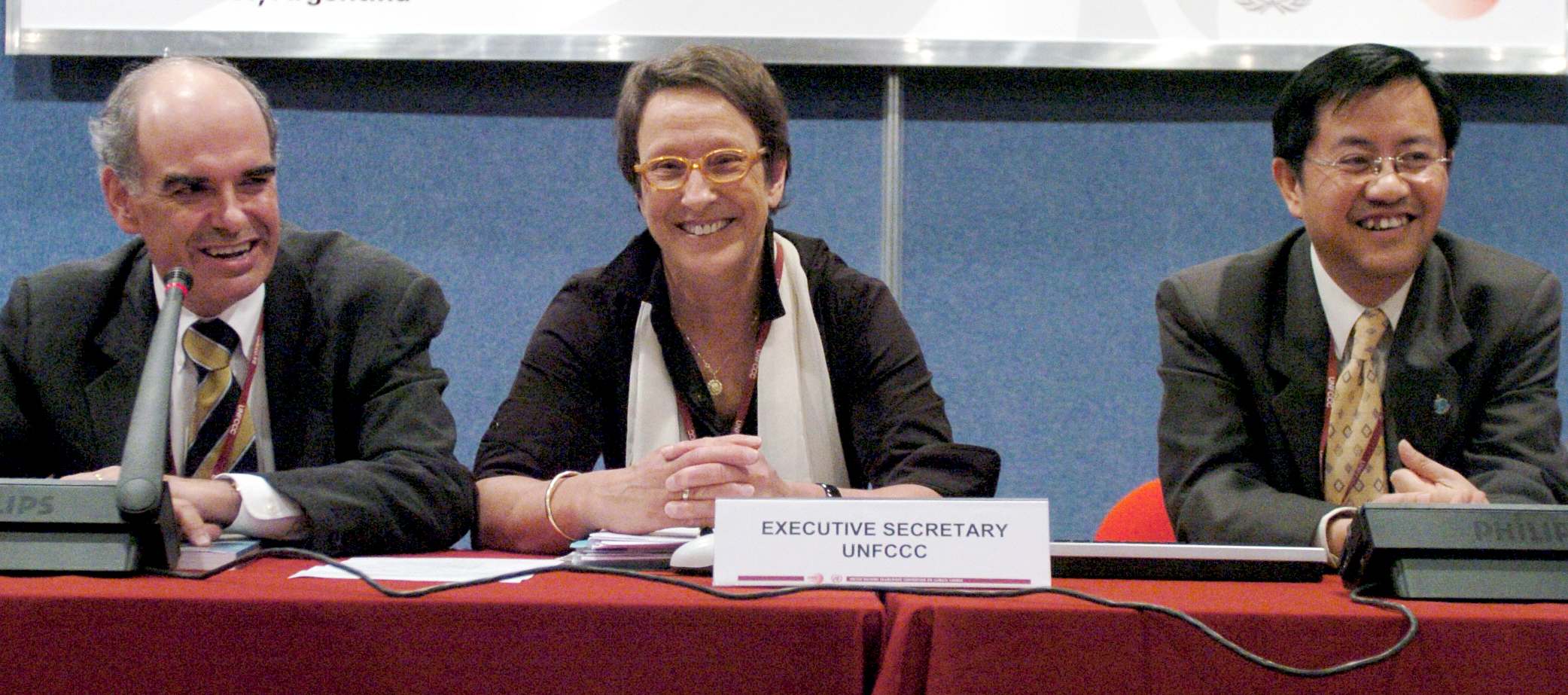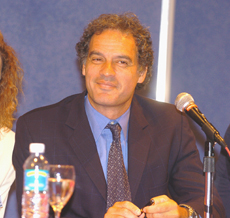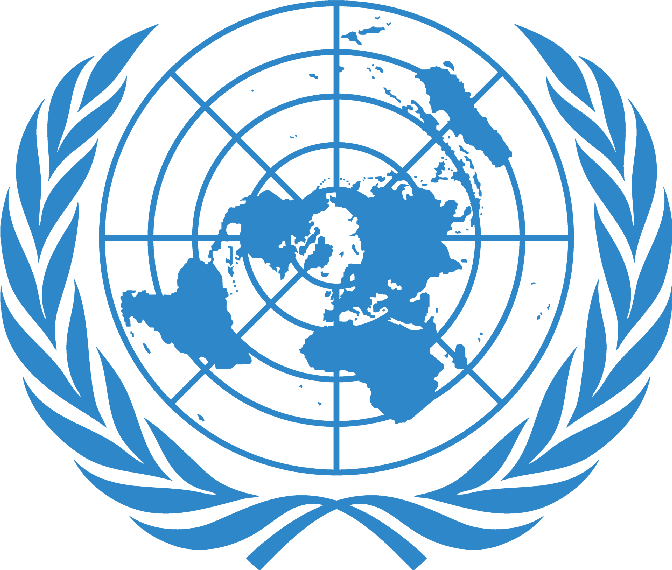|
UN
- CLIMATE
CHANGE COP 10 2004
Please use our
A-Z INDEX to
navigate this site, or our HOMEPAGE

COP 10
- Buenos Aires (Argentina) es varen adoptar decisions que desenvolupen el text del Protocol i faciliten l'aplicació dels mecanismes de flexibilitat. També s’hi varen prendre acords per avançar en els futurs límits d'emissions, s’hi va implementar un sistema mundial d'observació del clima i es va avançar de forma significativa en el programa sobre adaptació i atenuació del canvi climàtic.
Podeu veure una síntesi del temes tractats a la Conferència aquí.
Aquest any la Unió Europea aprova la Directiva 2004/101/CE, que inclou els mecanismes de flexibilitat del Protocol de Kyoto al mercat comunitari de drets d’emissió, modificació de la Directiva de comerç d’emissions, 2003/87/CE.
A l'Estat espanyol s'aprova la primera estratègia espanyola enfront del canvi climàtic i es crea el Grup Interministerial del Canvi Climàtic (GICC). S'aprova el Pla nacional d’assignacions 2005-2007, RD 1866/2004, de 6 de setembre
En la Declaració pel diàleg social, Govern, empresaris i sindicats acorden abordar el desenvolupament dels compromisos i les conseqüències del Protocol de Kyoto.
2004: COP 10, Buenos Aires, Argentina
COP10 discussed the progress made since the first Conference of the Parties 10 years ago and its future challenges, with special emphasis on climate change mitigation and adaptation.
To promote developing countries better adapt to climate change, the Buenos Aires Plan of Action was adopted.
The parties also began discussing the
post-Kyoto mechanism, on how to allocate emission reduction obligation following 2012, when the first commitment period ends.
The 2004 United Nations
Climate Change Conference took place between December 6 and December 17, 2004 in Buenos Aires, Argentina. The conference included the 10th Conference of the Parties (COP10) to the United Nations Framework Convention on Climate Change (UNFCCC).
The parties discussed the progress made since the first United Nations Climate Change Conference ten years ago and its future challenges, with special emphasis on climate change mitigation and adaptation. To promote developing countries better adapt to climate change, the Buenos Aires Plan of Action was adopted. The parties also began discussing the post-Kyoto mechanism, on how to allocate emission reduction obligation following 2012, when the first commitment period ends.

BUENOS
AIRES MAYOR FIGHTS CLIMATE CHANGE
Anibal Ibarra, Mayor of Buenos Aires, Argentina, stressed cities’ central role in addressing climate change and the importance of involving all cities in designing and implementing mitigation policies.
Ross Rocky Anderson, Mayor of Salt Lake City, US, outlined “Salt Lake City Green,” an environmental initiative applied to municipal operations, businesses and individuals, including programs designed at improving air quality and reducing greenhouse gas (GHG) emissions. He explained that Salt Lake City implements a high-performance buildings project aimed at minimizing the environmental impacts of construction, through the use of energy-efficient lighting, among others. He noted that ICLEI had been instrumental in implementing “Salt Lake City Green,” by providing necessary software and planning materials.
Patricia Ross, Councilor of Abbotsford, Canada, highlighted actions against the construction of a fossil-fuel power plant, and municipal environmental programs in the field of private and public transport, corporate environmental responsibility, waste conversion, and domestic energy consumption.
Domenico Zampaglione, Council member of Milan, Italy, said Milan’s activities to reduce GHG emissions focus on: the development of co-generation; provision of incentives to use natural gas and efficient heating systems technologies; and the use of renewable energy sources. He said Milan’s urban transport and transit system strategy promotes alternative fuels and low impact motorization systems, and noted that the city aims to increase its use of hydrogen fuel cells.
Marcello Lelis, Council member of Palmas, Brazil, highlighted his city’s preparation of an inventory for GHG emissions, use of organic waste for energy, and participation in Brazil's energy efficiency program. He said Palmas had developed its Project Design Document, and noted that the city’s urban carbon sequestration project involves all sectors of environmental management.
Imma Mayol, Deputy Mayor of Barcelona, Spain, indicated that Barcelona’s strategic ten-year plan is to reduce power use by 17% and GHG emissions by 20% by 2012, through the implementation of programs related to energy efficiency and use of renewable energy. She noted the adoption of construction standards and measures to reduce emissions from the public transport sector.
Bob Price, ICLEI, invited the panelists to sign the Local Government Declaration, which stresses mayors’ commitment to continue actions to combat climate change and seek additional resources from the private sector and central governments for implementation. He presented ICLEI’s activities related to the World Environment Day to be held in San Francisco, from 1-5 June 2005, and the Target Zero initiative, aimed at gathering commitment from cities around the world to exceed the Kyoto Protocol targets and achieve zero emissions growth.
Discussion: Participants enquired about various cities' programs. Regarding Buenos Aires, the adoption of an atmospheric quality standard act was noted, as well as the focus of the city’s climate protection program on expanding the subway system, increasing public streetlights efficiency, and promoting non-motorized transport and less carbon-intensive fuels.

ARCTIC
ASSESSMENT
Robert Corell, Arctic Climate Impact Assessment (ACIA), introduced the report “Impacts of a warming climate,” a scientific assessment of the social, economic and environmental impacts of climate change in the Arctic. He said from 1979-2003 the extent of the sea ice in the Arctic basin has decreased by 10% and the thickness by 40%. He explained how this reduces surface reflectivity and accelerates warming, and said the assessment predicts a sea level rise exceeding the 20-90 centimeters predicted by the Intergovernmental Panel on Climate Change.
Pål Prestrud, ACIA, noted that global circulation models all predict a 40-50% decrease in Arctic sea ice between 2010-2090, indicating that populations of ice-dependent Arctic species will decline. He said with reduced ice cover, the navigation season will increase from 30 to 120 days, noting with irony that this will increase the accessibility of Arctic fossil fuel reserves.
Terry Callaghan, Abisko Scientific Research Station, described how Arctic vegetation zones are expected to shift, with the treeline moving north and displacing tundra habitats in some areas. He explained how rapid climate change will result in forest fires, pest outbreaks and disease, and indicated that coastal communities will be subject to coastal erosion, increased flooding, and coastal retreat. He noted that thawing permafrost will affect ecosystems and result in increased emissions of methane, as well as disrupting transportation and destabilizing buildings and other infrastructure.
Lars-Otto Reiersen, Arctic Monitoring and Assessment Programme, described the effects of climate change on indigenous peoples in the Arctic. He indicated that the environment has become less predictable, that travel modes must be adapted to thinning of the ice, and that access to resources has become restricted with negative impacts on human health, food security and culture.
1995 COP
1,
BERLIN, GERMANY
1996 COP
2, GENEVA, SWITZERLAND
1997 COP
3, KYOTO, JAPAN
1998 COP
4, BUENOS AIRES, ARGENTINA
1999 COP
5, BONN, GERMANY
2000:COP
6, THE HAGUE, NETHERLANDS
2001 COP
7, MARRAKECH, MOROCCO
2002 COP
8, NEW DELHI, INDIA
2003 COP
9, MILAN, ITALY
2004 COP
10, BUENOS AIRES, ARGENTINA
2005 COP
11/CMP 1, MONTREAL, CANADA
2006 COP
12/CMP 2, NAIROBI, KENYA
2007 COP
13/CMP 3, BALI, INDONESIA
2008 COP
14/CMP 4, POZNAN, POLAND
2009
COP 15/CMP 5, COPENHAGEN, DENMARK
2010 COP
16/CMP 6, CANCUN, MEXICO
2011 COP
17/CMP 7, DURBAN, SOUTH AFRICA
2012 COP
18/CMP 8, DOHA, QATAR
2013 COP
19/CMP 9, WARSAW, POLAND
2014 COP
20/CMP 10, LIMA, PERU
2015 COP
21/CMP 11, Paris, France
2016 COP
22/CMP 12/CMA 1, Marrakech, Morocco
2017 COP
23/CMP 13/CMA 2, Bonn, Germany
2018 COP
24/CMP 14/CMA 3, Katowice, Poland
2019 COP
25/CMP 15/CMA 4, Santiago, Chile - Madrid, Spain
2020
COP 26/CMP 16/CMA 5, Glasgow, Scotland -
2021
COP 26/ Glasgow, Scotland
2022
COP 27/ Sharm El-Sheikh, Egypt, 6-18 November
2023
COP 28/ Expo City, Dubai, UAE, 30 Nov - 12 Dec
2024
COP 29/ Absheron, Baku, Azerbaijan 11 - 24 November
CONTACTS
The
UNFCCC secretariat is located at two different locations.
Main
office
UNFCCC secretariat
UN Campus
Platz der Vereinten Nationen 1
53113 Bonn
Germany
Haus Carstanjen Office
Martin-Luther-King-Strasse 8
53175 Bonn
Germany
Mailing address
UNFCCC secretariat
P.O. Box 260124
D-53153 Bonn
Germany
Phone: (49-228) 815-1000
Fax: (49-228) 815-1999
Web: http://unfccc.int
info@climateactionprogramme.org
http://www.climateactionprogramme.org
DESERTIFICATION
COP HISTORY
|
COP
1:
Rome, Italy, 29 Sept to 10 Oct 1997
|
COP
9: Buenos Aires, Argentina, 21 Sept to 2 Oct
2009
|
|
COP
2: Dakar, Senegal, 30 Nov to 11 Dec 1998
|
COP
10: Changwon, South Korea, 10 to 20 Oct 2011
|
|
COP
3: Recife, Brazil, 15 to 26 Nov 1999
|
COP
11: Windhoek, Namibia, 16 to 27 Sept 2013
|
|
COP
4: Bonn, Germany, 11 to 22 Dec 2000
|
COP
12: Ankara, Turkey, 12 to 23 Oct 2015
|
|
COP
5: Geneva, Switzerland, 1 to 12 Oct 2001
|
COP
13: Ordos City, China, 6 to 16 Sept 2017
|
|
COP
6: Havana, Cuba, 25 August to 5 Sept 2003
|
COP
14: New Delhi, India, 2 to 13 Sept 2019
|
|
COP
7: Nairobi, Kenya, 17 to 28 Oct 2005
|
COP
15: 2020
|
|
COP
8: Madrid, Spain, 3 to 14 Sept 2007
|
COP
16: 2021
|
BIODIVERSITY
COP HISTORY
|
COP
1:
1994 Nassau, Bahamas, Nov & Dec
|
COP
8: 2006 Curitiba, Brazil, 8 Mar
|
|
COP
2: 1995 Jakarta, Indonesia, Nov
|
COP
9: 2008 Bonn, Germany, May
|
|
COP
3: 1996 Buenos Aires, Argentina, Nov
|
COP
10: 2010 Nagoya, Japan, Oct
|
|
COP
4: 1998 Bratislava, Slovakia, May
|
COP
11: 2012 Hyderabad, India
|
|
EXCOP:
1999 Cartagena, Colombia, Feb
|
COP
12: 2014 Pyeongchang, Republic of Korea, Oct
|
|
COP
5: 2000 Nairobi, Kenya, May
|
COP
13: 2016 Cancun, Mexico, 2 to 17 Dec
|
|
COP
6: 2002 The Hague, Netherlands, April
|
COP
14: 2018 Sharm El-Sheikh, Egypt, 17 to 29
Nov
|
|
COP
7: 2004 Kuala Lumpur, Malaysia, Feb
|
COP
15: 2020 Kunming, Yunnan, China
|

LINKS
& REFERENCE
https://enb.iisd.org/climate/cop10/enbots/13dec.html
http://www.climateactionprogramme.org
This
website is provided on a free basis as a public information
service.
|


